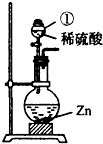某学习小组对硫酸进行如下研究:
(1)如图中仪器①的名称为______,发生反应的化学方程式为______.该装置也可用于实验室制______气体(任写一种),化学方程式为______.
(2)已知相同温度下,硫酸的质量分数越大溶液的酸性越强.常温下18%的稀硫酸的pH______2% 的稀硫酸(填“>”、“<”或“=”).若对稀硫酸进行如下操作,溶液的pH因化学变化而升高的有______(填字母).
A.加少量水 B.加少量铁粉 C.加少量氢氧化钾 D.加少量浓硫酸
(3)向两个烧杯中分别注入浓硫酸(溶质质量分数为98%,密度为1.84g/m3)和稀硫酸(浓硫酸与水的体积比1:1)各10ml,称量并记录不同时间(h)两种硫酸溶液吸水的质量(g)数据见下表:
| 时间/h | 1 | 1.5 | 4 | 8 | 12 | 24 | 48 | 60 | |
| 吸水质量/g | 浓硫酸 | 1.6 | 2.2 | 6.2 | 10.3 | 14.0 | 20.9 | 29.2 | 32.1 |
| 稀硫酸 | 1.2 | 1.5 | 3.5 | 5.9 | 8.1 | 12.9 | 19.5 | 21.0 | |
②由表中实验数据可知:
a.有关硫酸吸水性的说法不正确的是______(填字母).
A.浓、稀硫酸都有吸水性 B.只有浓硫酸有吸水性 C.浓硫酸吸水性较稀硫酸强
b.实验室保存稀硫酸时要______存放,在干燥气体对应选用______ 硫酸作干燥剂(填“浓”或“稀”).

解(1)图中仪器①的名称为分液漏斗,锌与稀硫酸反应生成了硫酸锌和氢气,反应的方程式是:Zn+H2SO4=ZnSO4+H2↑,由制取气体的装置可知,反应物的状态固体和液体,反应条件不需要加热,利用这套装置可选用石灰石和盐酸反应制取二氧化碳,反应的方程式是:CaCO3+2HCl=CaCl2+H2O+CO2↑;
(2)因为相同温度下,硫酸的质量分数越大溶液的酸性越强,溶液的pH越小,所以常温下18%的稀硫酸的pH<2% 的稀硫酸;向稀硫酸中加入铁粉时,铁和硫酸反应,酸性转减弱,溶液的pH要增大,向稀硫酸中加入氢氧化钾时,氢氧化钾和硫酸反应,溶液的pH要增大,所以,溶液的pH因化学变化而升高的有 BC;
(3)①要配置体积比为1:1稀硫酸,设取溶质质量分数为98%的浓硫酸的体积为v,取水的体积也为v,则体积比为1:1稀硫酸的溶质质量分数计算表达式为:
×100%;在量取时浓硫酸时是俯视读数,实际量取的浓硫酸少了,所配置的稀硫酸的质量分数偏小;v×1.84g/cm3×98% v×1.84g/cm3+v×1g/cm3
②a由表中的数据可知:浓、稀硫酸都有吸水性,浓硫酸的吸水性比稀硫酸的吸水性强;
b由于浓硫酸有吸水性,所以,浓硫酸在保存时要密封保存,可用作某些气体的干燥剂.
故答为:
(1)分液漏斗,Zn+H2SO4=ZnSO4+H2↑,二氧化碳,CaCO3+2HCl=CaCl2+H2O+CO2↑;
(2)<,B C;
(3)①为
×100%,偏小;②a B,b密封,浓.v×1.84g/cm3×98% v×1.84g/cm3+v×1g/cm3
